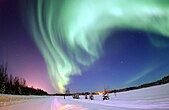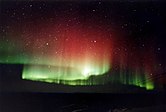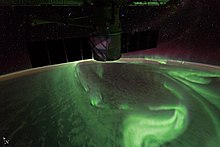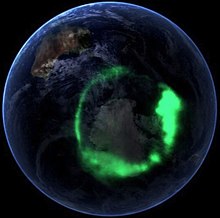An aurora, also commonly known as the polar lights, is a natural light display in Earth‘s sky, predominantly seen in high-latitude regions (around the Arctic and Antarctic). Auroras display dynamic patterns of brilliant lights that appear as curtains, rays, spirals, or dynamic flickers covering the entire sky.
Auroras are the result of disturbances in the magnetosphere caused by the solar wind. Major disturbances result from enhancements in the speed of the solar wind from coronal holes and coronal mass ejections. These disturbances alter the trajectories of charged particles in the magnetospheric plasma. These particles, mainly electrons and protons, precipitate into the upper atmosphere (thermosphere/exosphere). The resulting ionization and excitation of atmospheric constituents emit light of varying colour and complexity. The form of the aurora, occurring within bands around both polar regions, is also dependent on the amount of acceleration imparted to the precipitating particles.
Most of the planets in the Solar System, some natural satellites, brown dwarfs, and even comets also host auroras.
Etymology
The word “aurora” is derived from the name of the Roman goddess of the dawn, Aurora, who travelled from east to west announcing the coming of the sun. Ancient Greek poets used the corresponding name Eos metaphorically to refer to dawn, often mentioning its play of colors across the otherwise dark sky.
The words “borealis” and “australis” are derived from the names of the ancient gods of the north wind (Boreas) and the south wind (Auster).
Occurrence
Earth’s atmosphere as it appears from space, as bands of different colours at the horizon. From the bottom, afterglow illuminates the troposphere in orange with silhouettes of clouds, and the stratosphere in white and blue. Next the mesosphere (pink area) extends to just below the edge of space at one hundred kilometers and the pink line of airglow of the lower thermosphere (dark), which hosts green and red aurorae over several hundred kilometers.
Most auroras occur in a band known as the “auroral zone”, which is typically 3° to 6° wide in latitude and between 10° and 20° from the geomagnetic poles at all local times (or longitudes), most clearly seen at night against a dark sky. A region that currently displays an aurora is called the “auroral oval”, a band displaced by the solar wind towards the night side of Earth. Early evidence for a geomagnetic connection comes from the statistics of auroral observations. Elias Loomis (1860), and later Hermann Fritz (1881) and Sophus Tromholt (1881) in more detail, established that the aurora appeared mainly in the auroral zone.
In northern latitudes, the effect is known as the aurora borealis or the northern lights. The former term was coined by Galileo in 1619, from the Roman goddess of the dawn and the Greek name for the north wind. The southern counterpart, the aurora australis or the southern lights, has features almost identical to the aurora borealis and changes simultaneously with changes in the northern auroral zone. The aurora australis is visible from high southern latitudes in Antarctica, Chile, Argentina, South Africa, New Zealand and Australia. The aurora borealis is visible from being close to the center of the Arctic Circle such as Alaska, the Canadian Territories, Iceland, Greenland, Norway, Sweden, Finland and Russia. On rare occasions the aurora borealis can be seen further south, for example in Estonia, Latvia, Lithuania, Scotland, Ireland, Denmark, and the northern part of the contiguous United States.
A geomagnetic storm causes the auroral ovals (north and south) to expand, bringing the aurora to lower latitudes. The instantaneous distribution of auroras (“auroral oval”) is slightly different, being centered about 3–5° nightward of the magnetic pole, so that auroral arcs reach furthest toward the equator when the magnetic pole in question is in between the observer and the Sun. The aurora can be seen best at this time, which is called magnetic midnight.
Auroras seen within the auroral oval may be directly overhead, but from farther away, they illuminate the poleward horizon as a greenish glow, or sometimes a faint red, as if the Sun were rising from an unusual direction. Auroras also occur poleward of the auroral zone as either diffuse patches or arcs which can be subvisual.
Causes
A full understanding of the physical processes which lead to different types of auroras is still incomplete, but the basic cause involves the interaction of the solar wind with Earth’s magnetosphere. The varying intensity of the solar wind produces effects of different magnitudes but includes one or more of the following physical scenarios.
- A quiescent solar wind flowing past Earth’s magnetosphere steadily interacts with it and can both inject solar wind particles directly onto the geomagnetic field lines that are ‘open’, as opposed to being ‘closed’ in the opposite hemisphere, and provide diffusion through the bow shock. It can also cause particles already trapped in the radiation belts to precipitate into the atmosphere. Once particles are lost to the atmosphere from the radiation belts, under quiet conditions, new ones replace them only slowly, and the loss-cone becomes depleted. In the magnetotail, however, particle trajectories seem constantly to reshuffle, probably when the particles cross the very weak magnetic field near the equator. As a result, the flow of electrons in that region is nearly the same in all directions (“isotropic”) and assures a steady supply of leaking electrons. The leakage of electrons does not leave the tail positively charged, because each leaked electron lost to the atmosphere is replaced by a low energy electron drawn upward from the ionosphere. Such replacement of “hot” electrons by “cold” ones is in complete accord with the second law of thermodynamics. The complete process, which also generates an electric ring current around Earth, is uncertain.
- Geomagnetic disturbance from an enhanced solar wind causes distortions of the magnetotail (“magnetic substorms”). These ‘substorms’ tend to occur after prolonged spells (on the order of hours) during which the interplanetary magnetic field has had an appreciable southward component. This leads to a higher rate of interconnection between its field lines and those of Earth. As a result, the solar wind moves magnetic flux (tubes of magnetic field lines, ‘locked’ together with their resident plasma) from the day side of Earth to the magnetotail, widening the obstacle it presents to the solar wind flow and constricting the tail on the night-side. Ultimately some tail plasma can separate (“magnetic reconnection“); some blobs (“plasmoids“) are squeezed downstream and are carried away with the solar wind; others are squeezed toward Earth where their motion feeds strong outbursts of auroras, mainly around midnight (“unloading process”). A geomagnetic storm resulting from greater interaction adds many more particles to the plasma trapped around Earth, also producing enhancement of the “ring current”. Occasionally the resulting modification of Earth’s magnetic field can be so strong that it produces auroras visible at middle latitudes, on field lines much closer to the equator than those of the auroral zone.
-
Moon and aurora
-
- Acceleration of auroral charged particles invariably accompanies a magnetospheric disturbance that causes an aurora. This mechanism, which is believed to predominantly arise from strong electric fields along the magnetic field or wave-particle interactions, raises the velocity of a particle in the direction of the guiding magnetic field. The pitch angle is thereby decreased and increases the chance of it being precipitated into the atmosphere. Both electromagnetic and electrostatic waves, produced at the time of greater geomagnetic disturbances, make a significant contribution to the energizing processes that sustain an aurora. Particle acceleration provides a complex intermediate process for transferring energy from the solar wind indirectly into the atmosphere.








